Renault MEGANE 3 2011 Manual
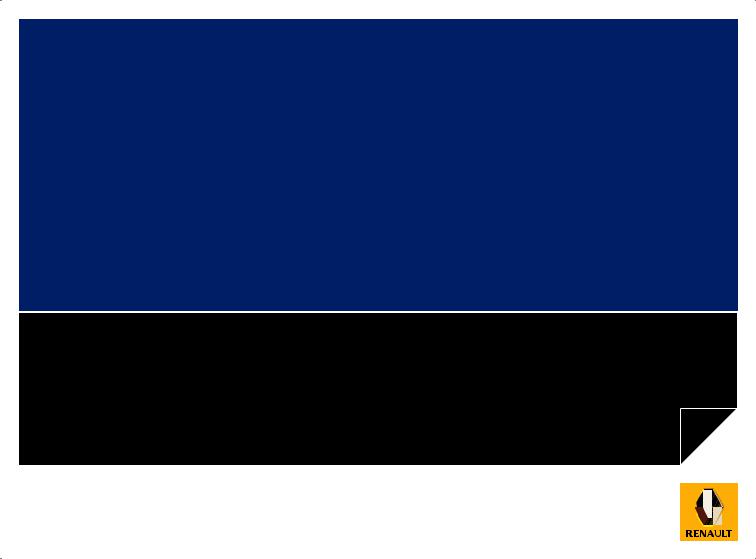
MEGANE
DRIVER’S HANDBOOK

RENAULT recommends ELF
ELF has developed a complete range of lubricants for RENAULT:
fengine oils
fmanual and automatic gearbox oils
Warning: to ensure the engine operates optimally, the use of a lubricant may be restricted to certain vehicles. Please refer to your maintenance document.
Benefiting from the research applied to Formula 1, lubricants are very high-tech products.
Updated with the help of RENAULT’s technical teams, this range is perfectly compatible with the specific features of the brand’s vehicles. f ELF lubricants enhance your vehicle’s performance significantly.
Photo credit: Total/DPPI Imacom group
RENAULT recommends approved ELF lubricants for oil changes and top-ups. Contact your RENAULT Dealer or visit www.lubrifiants.elf.com
Une marque de
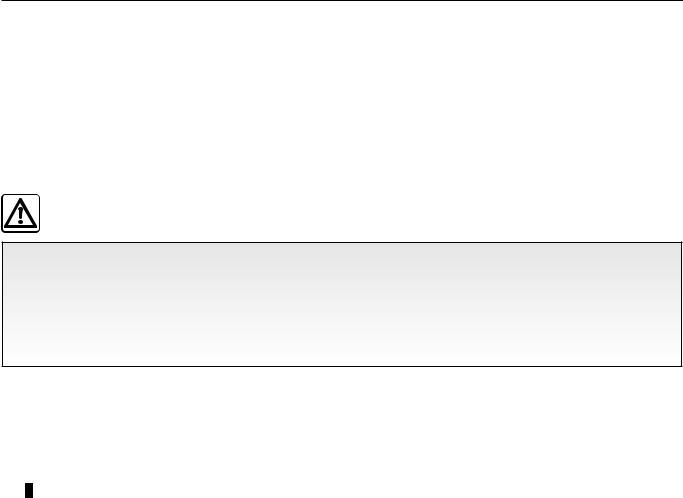
Welcome to your new vehicle
This Driver’s Handbook contains the information necessary:
–for you to familiarise yourself with your vehicle, to use it to its best advantage and to benefit fully from the all the functions and the technical developments it incorporates.
–to ensure that it always gives the best performance by following the simple, but comprehensive advice concerning regular maintenance.
–to enable you to deal quickly with minor faults not requiring specialist attention.
It is well worth taking a few minutes to read this handbook to familiarise yourself with the information and guidelines it contains about the vehicle and its functions and new features. If certain points are still unclear, our Network technicians will be only too pleased to provide you with any additional information.
The following symbol will help you when reading this handbook:
To indicate a hazard, danger or safety recommendation.
The descriptions of the models given in this handbook are based on the technical specifications at the time of writing. This handbook covers all items of equipment (both standard and optional) available for these models but whether or not these are fitted to the vehicle depends on the version, options selected and the country where the vehicle is sold.
This handbook may also contain information about items of equipment to be introduced later in the model year.
Throughout the manual, the “approved Dealer” is your RENAULT Dealer.
Enjoy driving your new vehicle.
Translated from French. Copying or translation, in part or in full, is forbidden unless prior written permission has been obtained from the vehicle manufacturer.
0.1

0.2
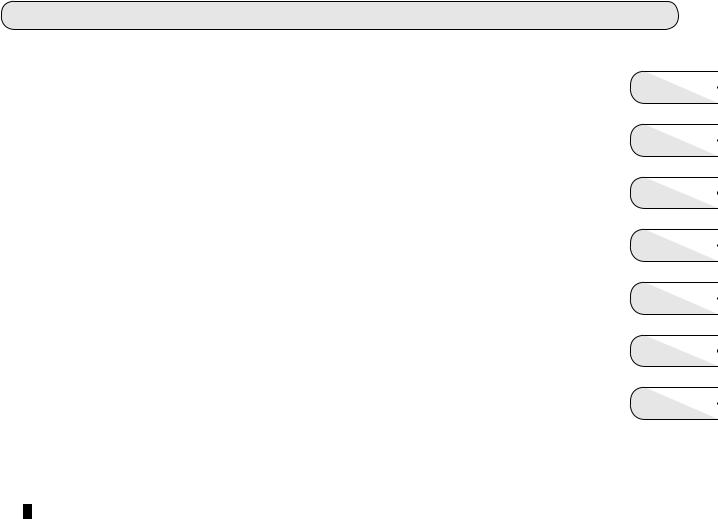
C O N T E N T S
Sections
Getting to know your vehicle ...............................
Driving ...................................................................
Your comfort .........................................................
Maintenance ..........................................................
Practical advice .....................................................
Technical specifications ......................................
Alphabetical index ................................................
1
2
3
4
5
6
7
0.3

0.4

Section 1: Getting to know your vehicle
RENAULT cards: general information, use, deadlocking . . . . . . . . . . . . . . . . . |
1.2 |
|
||
Doors. . . . . . . . . . . . . . . . . . . . . . . . . . . . . . . . . . . . . |
1.10 |
|
||
|
||||
Automatic locking of opening elements when driving. . . . . . . . . . . . . . . . . . . |
1.14 |
|
||
Headrests - Seats. . . . . . . . . . . . . . . . . . . . . . . . . . . . . . . . |
1.15 |
|
||
|
||||
Seats. . . . . . . . . . . . . . . . . . . . . . . . . . . . . . . . . . . . . |
1.17 |
|
||
Seat belts. . . . . . . . . . . . . . . . |
. . . . |
. . . . . . . . . . . . . . . . . . . . . . . . . . . . . . . . . . . . . . . . . . . . . . . . . . |
1.22 |
|
Additional methods of restraint:. . . . . . . . . . . . . . . . . . . . . . . . . . . |
1.25 |
|
||
to the front seat belts. . . . . . . . . . . . . . . . . . . . . . . . . . . . |
1.25 |
|
||
to the rear seat belts . . . . . . . . . . . . . . . . . . . . . . . . . . . . |
1.29 |
|
||
side protection. . . . . . . . . . . . . . . . . . . . . . . . . . . . . . . |
1.30 |
|
||
Child safety: general information. . . . . . . . . . . . . . . . . . . . . . . . . . . |
1.32 |
|
||
choosing a child seat mounting. . . . . . . . . . . . . . . . . . . . . . . . |
1.35 |
|
||
Fitting a child seat . . . . . . . . . . . . . . . . . . . . . . . . . . . . . |
1.37 |
|
||
deactivating, activating the front passenger air bag. . . . . . . . . . . . . . . . . |
1.43 |
|
||
Driving position. . . . . . . . . . . . . . . . . . . . . . . . . . . . . . . . . |
1.46 |
|
||
Control instruments. . . . . . . . . . . . . . . . . . . . . . . . . . . . . . . . |
1.50 |
|
||
trip computer . . . . . . . . . . . . . . . . . . . . . . . . . . . . . . . |
1.56 |
|
||
vehicle settings customisation menu. . . . . . . . . . . . . . . . . . . . . . |
1.66 |
|
||
Steering wheel. . . . . . . . . . . . . . . . . . . . . . . . . . . . . . . . . . |
1.67 |
|
||
Power-assisted steering . . . . . . . . . . . . . . . . . . . . . . . . . . . . . . |
1.67 |
|
||
Clock and exterior temperature. . |
. . . . . . . . . . . . . . . . . . . . . . . . . |
1.68 |
|
|
Rear-view mirrors . . . . . . . . . . . . . . . . . . . . . . . . . . . . . . . . |
1.69 |
|
||
Audible and visual signals. . |
. . . . . . . . . . . . . . . . . . . . . . . . . . . |
1.70 |
|
|
Exterior lighting and signals. . |
. . . . |
. . . . . . . . . . . . . . . . . . . . . . . . . . . . . . . . . . . . . . . . . . . . . . . . . . |
1.71 |
|
Headlight beam adjustment. . . . . . . . . . . . . . . . . . . . . . . . . . . . . |
1.74 |
|
||
Wash/Wipe . . . . . . . . . . . . . . . . . . . . . . . . . . . . . . . . . . . |
1.75 |
|
||
Fuel tank (filling with fuel). . . . . . . . . . . . . . . . . . . . . . . . . . . . . |
1.78 |
|
||
1.1
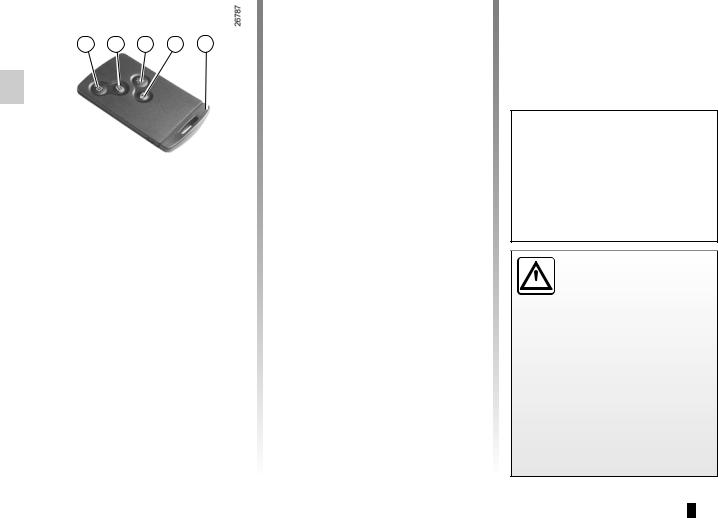
RENAULT cards: general information (1/2)
1 |
2 |
3 |
4 |
5 |
1Unlocking the doors and tailgate.
2Locking all doors and tailgate.
3Switching on the lighting remotely.
4Unlocking/locking the tailgate
5Integrated key.
Special note
The RENAULT “SERVICE” card, on equipped vehicles, can be identified by the word “SERVICE” engraved on the card. Refer to the information on the RENAULT “SERVICE” card in section 1.
The RENAULT card is used for:
–locking/unlocking the doors and tailgate (doors, tailgate) and the fuel filler flap (see the following pages);
–switching on the vehicle lighting remotely (refer to the following pages);
–depending on the vehicle, automatically closing the electric windows and sunroof remotely (see the information on “Electric windows/Electric sunroof” in Section 3);
–starting the engine; refer to the information on “Starting the engine” in Section 2.
Battery life
Make sure that the correct battery type is being used, and that the battery is in good condition and inserted correctly. Its service life is approximately two years: replace it when the message “Keycard battery low” appears on the instrument panel (refer to the information on the “RENAULT card: battery" in section 5).
Range of the RENAULT card
This varies according to the surroundings. It is important to make sure when handling the RENAULT card that you do not lock or unlock the doors by inadvertently pressing the buttons.
When the battery is flat, you can still lock/unlock and start your vehicle. Refer to the information on “Locking/unlocking the doors” in Section 1 and “Starting the engine” in Section 2.
Driver’s responsibility
Never leave your vehicle
 with the RENAULT card inside and never leave a child (or a pet) unsupervised, even
with the RENAULT card inside and never leave a child (or a pet) unsupervised, even
for a short while.
They may pose a risk to themselves or to others by starting the engine, activating equipment such as the electric windows or by locking the doors.
Risk of serious injury.
1.2
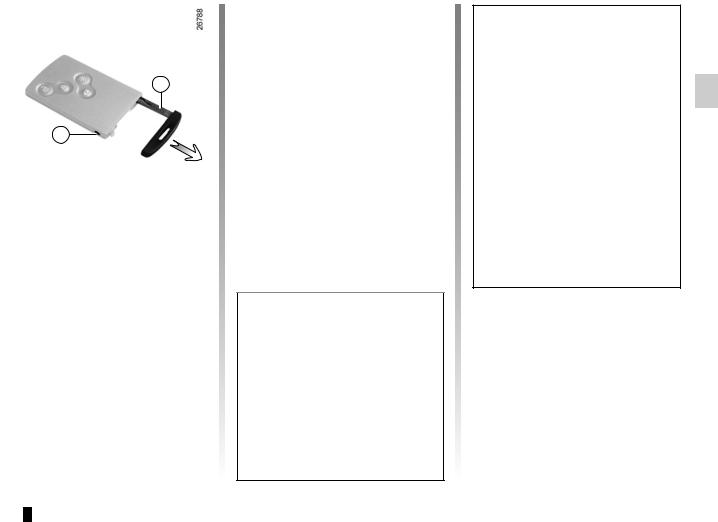
RENAULT cards: general information (2/2)
5 |
6 |
Integrated key 5
The integrated key is used to lock or unlock the front left-hand door if the RENAULT card does not work:
–when the RENAULT card battery is drained, flat battery, etc.
–use of devices using the same frequency as the card;
–if the vehicle is located in a zone of high electromagnetic radiation;
Access to key 5
Press button 6 and pull on key 5 then release the button.
Using the key
Refer to the information on “Locking/ unlocking the doors”.
Once you have accessed the vehicle using the integrated key, replace it in its housing in the RENAULT card, then insert the RENAULT card into the card reader to start the vehicle.
Advice
Avoid leaving the card in hot, cold or humid areas.
Do not keep the RENAULT card in a place where it could be bent or damaged accidentally, such as in a back pocket of a garment.
Replacement: need for an additional RENAULT Card
If you lose your RENAULT card or require another, you can obtain one from an approved dealer.
If a RENAULT card is replaced, it will be necessary to take the vehicle and all of its RENAULT cards to an approved dealer to initialise the system.
You may use up to four RENAULT cards per vehicle.
1.3
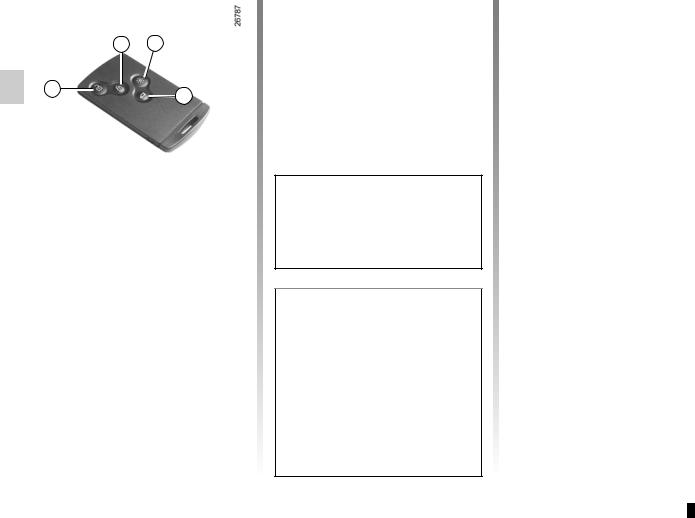
Remote control RENAULT card: use
2 |
3 |
1 |
4 |
|
Unlocking the doors and tailgate
Press button 1.
The hazard warning lights flash once to indicate that the doors have been unlocked.
When unlocking is only active for the driver’s door, (refer to the information on the “vehicle settings customisation menu” in Section 1):
–pressing button 1 unlocks only the driver’s door and the fuel filler flap;
–pressing button 1 twice unlocks all the doors and the tailgate.
Locking the doors and luggage compartment
Press the locking button 2. The hazard warning lights flash twice to indicate that the doors have locked. If a door or the luggage compartment is open or not properly shut, or if a RENAULT card is still in the reader, the doors and luggage compartment lock then quickly unlock and the hazard warning lights do not flash.
If the vehicle has been unlocked but neither the doors or tailgate are open, it locks again automatically after two minutes.
The card buttons are deactivated when the engine is running.
The flashing status of the hazard warning lights informs you of the vehicle status:
–one flash indicates that the vehicle is completely unlocked;
–two flashes indicate that the vehicle is completely locked.
Unlocking/locking the luggage compartment only
Press button 4 to unlock/lock the luggage compartment.
RENAULT card not detected alarm
If a door is opened when the engine is running and the card is not in the reader, the message “Keycard not detected” and a beep will warn you of this. The warning disappears when the card is inserted in the reader again.
Distance lighting function
The dipped beam headlights, indicator lights and interior lights come on for approximately 30 seconds when button 3 is pressed. This can be used, for example, to identify the vehicle from a distance when parked in a car park.
Note: pressing button 3 again switches off the lighting.
1.4
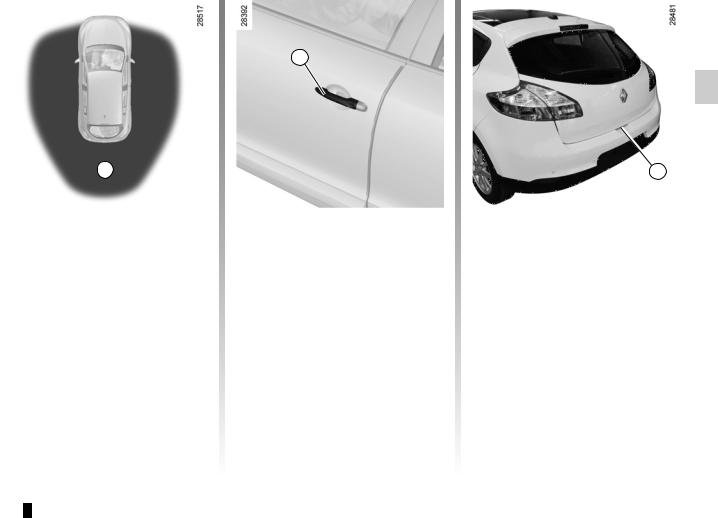
Hands-free RENAULT card: use (1/3)
1
Use
On equipped vehicles, in addition to the functions of the remote control RENAULT card, it can be used to lock/ unlock without using the RENAULT card, when it is in access zone 1.
Note: ensure that the RENAULT card is not in contact with other electronic equipment (computer, PDA, phone, etc.) as this could hinder its operation.
2 |
3 |
Unlocking the vehicle
With the RENAULT card in zone 1, place your hand on a door handle 2: the vehicle will unlock (in some cases, you may need to pull door handle 2 twice to unlock the vehicle and open the door).
Pressing the button 3 also unlocks all the doors and the tailgate.
The hazard warning lights flash once to indicate that the doors have been unlocked.
1.5
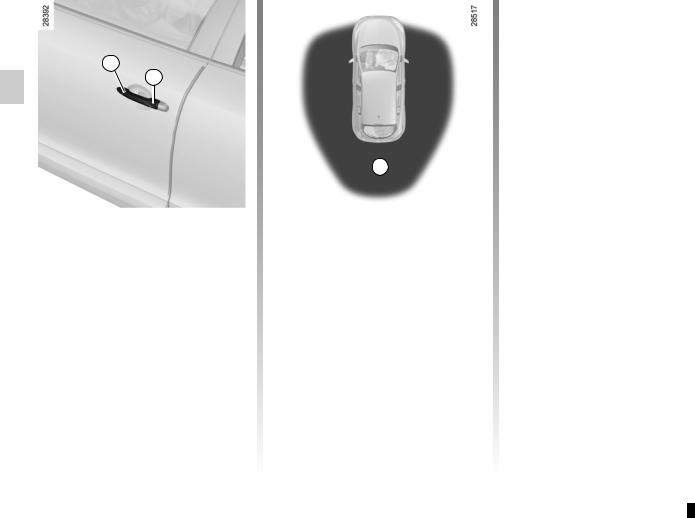
Hands-free RENAULT card: use (2/3)
2 |
4 |
Locking the vehicle
There are three ways to lock the vehicle: remotely, using button 4, or using the RENAULT card.
Remote locking
With the RENAULT card on you, and doors and tailgate closed, move away from the vehicle: it will lock automatically once you have left zone 1.
Note: the distance at which the vehicle locks depends on the surroundings.
1
The hazard warning lights flash twice and a beep sounds to indicate that the doors have locked.
The beep may be switched off. Consult an approved Dealer.
If a door or the tailgate is open or not properly shut, or a card is in the passenger compartment (or the card reader) the vehicle will not lock. In this situation, no beep sounds and the hazard warning lights do not flash.
Locking using button 4
With the doors and luggage compartment closed, press button 4 on the driver’s door handle. The vehicle will lock. If a door or the tailgate is open or not closed properly, the vehicle will quickly lock/unlock.
Note: a RENAULT card must be within the vehicle's access zone (zone 1) to be able to lock the vehicle using the button.
Special note:
If you wish to check that the doors are locked after locking using button 4, you have approximately three seconds to try the door handles without unlocking them.
After this delay, the hands-free mode is activated once again and any movement of a handle will unlock the vehicle.
1.6
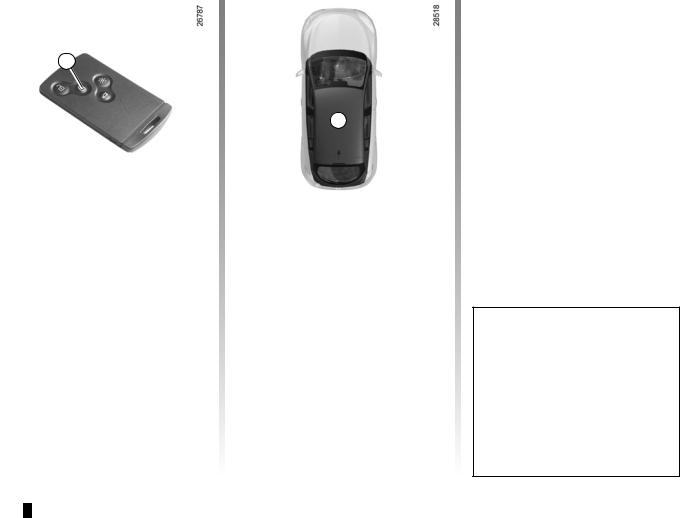
Hands-free RENAULT card: use (3/3)
5 |
|
With the engine running, if after |
|
|
having opened and closed a door the |
|
|
card is no longer in the passenger com- |
|
|
partment, the message Keycard not de- |
|
|
tected (accompanied by a beep when |
|
|
the speed exceeds a certain level) |
|
|
|
|
|
warns you that the card is no longer |
|
|
in the vehicle. This avoids you driving |
|
6 |
away after having dropped off a pas- |
|
senger who has the card, for example. |
|
The warning disappears when the card is detected again.
Locking the vehicle (continued)
Locking using the RENAULT card
With the doors and luggage compartment closed, press button 5: the vehicle will lock.
The hazard warning lights flash twice to indicate that the doors have locked.
Note: the maximum distance at which the vehicle locks depends on the surroundings.
Special note:
The vehicle will not lock if:
–a door or the tailgate is open or not properly closed;
–a card is still in zone 6 (or in the card reader) and no other card is in the external detection zone.
After locking/unlocking the vehicle or the luggage compartment only using the buttons on the RENAULT card, remote locking and unlocking in hands-free mode are deactivated.
To reactivate the “hands-free” mode: restart the vehicle.
1.7

RENAULT card: deadlocking
1 |
2 |
3 |
To deactivate deadlocking
Unlock the vehicle using button 1 on the RENAULT card.
The hazard warning lights flash once to indicate that the doors have been unlocked.
If the vehicle is equipped with a deadlocking function, this allows you to lock the opening elements and to prevent the doors from being unlocked using the interior handles (for example, by breaking the window and then trying to open the door from the inside).
Never use deadlocking if someone is still inside the vehicle.
To activate deadlocking
You can choose between two deadlocking activation modes:
–press button 2 twice in quick succession;
–or, press the button on the driver’s door handle 3 twice in quick succession.
The hazard warning lights flash five times to indicate locking.
Activating deadlocking also remotely closes the windows and/or the electric sunroof, on equipped vehicles.
After activating the deadlocking function using button 2, remote locking and unlocking in hands-free mode are deactivated.
To reactivate the “hands-free” mode: restart the vehicle.
1.8
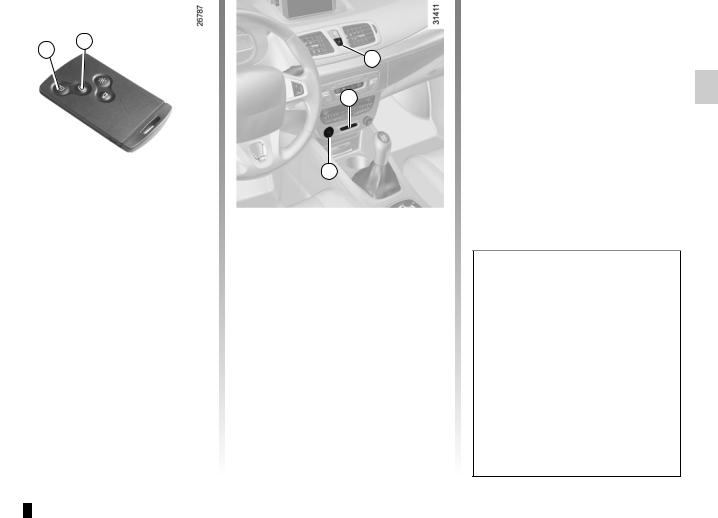
RENAULT card “service”
1 |
2 |
|
If the vehicle is equipped with this card, it can be identified by the word “SERVICE” engraved on the card.
In certain situations, you may wish to entrust your vehicle to a third party (parking valet, mechanic, etc.) whilst restricting its operation.
The RENAULT “SERVICE” card enables the vehicle to be locked but only allows the driver's door to be unlocked and the engine to be started.
3 |
4 |
5 |
Activation of the “SERVICE” mode.
Insert the RENAULT “SERVICE” card into the card reader 4. All the vehicle opening elements lock (except the driver’s door).
If they do not, with the engine switched off, press button 1 (all the doors and the tailgate lock, with the exception of the driver’s door) or 2 (the entire vehicle locks) on the RENAULT “SERVICE” card.
Deactivation of the “SERVICE” mode
There are two possibilities:
–Press a button on the RENAULT card (not the RENAULT “SERVICE” card);
–start the engine with a RENAULT card (not the RENAULT “SERVICE” card). With the card in reader 4, press button 5.
The interior locking/unlocking switch 3 is deactivated while the vehicle is in use with the RENAULT “SERVICE” card.
Each vehicle only has one RENAULT “SERVICE” card.
When using a RENAULT “SERVICE” card, the other cards retain all their functions.
1.9
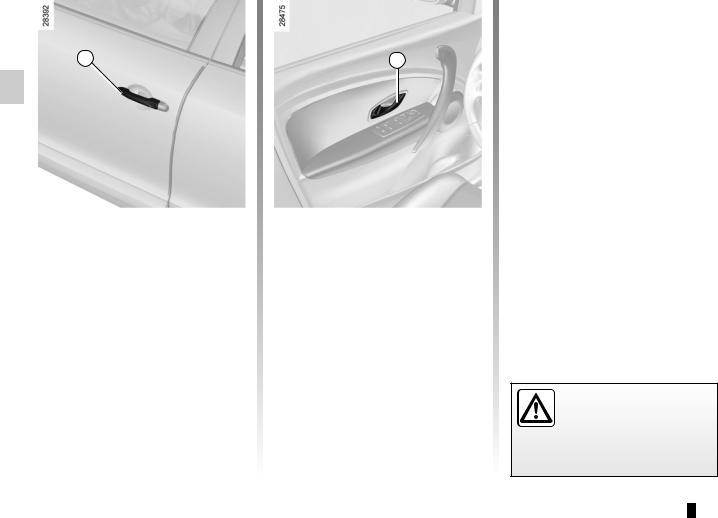
Opening and closing the doors (1/2)
1 |
2 |
Opening the doors from the outside
With the doors unlocked or the “handsfree” RENAULT card in your possession, hold handle 1 and pull it towards you.
In some cases, it may be necessary to pull the handle twice to open the door.
Opening from the inside
Pull on the handle 2.
Lights-on reminder buzzer
If you have switched off the ignition and left the lights switched on, a reminder buzzer will sound when a door is opened.
Card reminder buzzer
When the driver’s door is opened and the card is still in the reader, the message “Please remove keycard” appears on the instrument panel, accompanied by a beep.
Door/tailgate open buzzer
If a door or the luggage compartment is open or not properly closed, once the vehicle reaches 6 mph (10 km/h), the message “Boot open” or “Door open” (depending on the door) appears on the instrument panel, accompanied by a warning light.
Special note
After switching off the engine, the lights and any accessories that are in operation (radio, etc.) will continue to operate.
They stop as soon as the driver’s door is opened.
As a safety precaution, the doors should only be opened or closed when the vehicle is stationary.
1.10
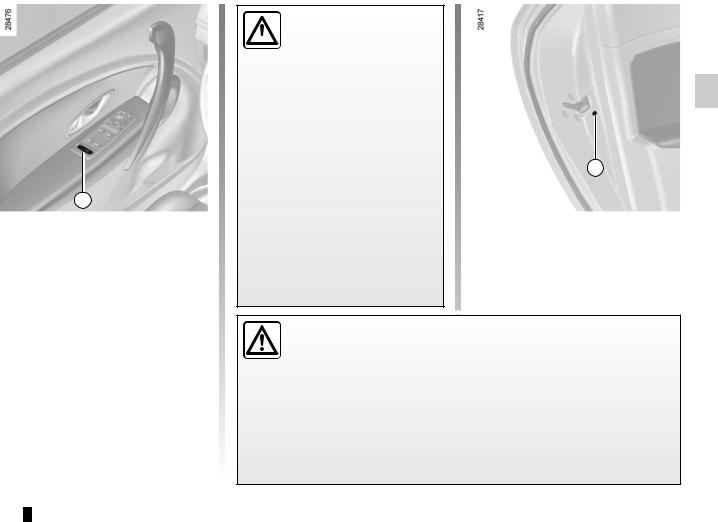
Opening and closing the doors (2/2)
1 |
Child safety
ÇVehicle with switch 1
Press switch 1 to authorise
opening of the rear doors. If the vehicle is equipped with electric rear windows, this action will also authorise their use. The indicator light in the switch lights up to confirm that the locks have been activated.
Note: if there is a system fault, the message “Check child safety device” is displayed on the instrument panel: contact an approved Dealer.
Safety of rear occupants
The driver can authorise  operation of the rear doors and, depending on the vehicle, the electric windows by press-
operation of the rear doors and, depending on the vehicle, the electric windows by press-
ing switch 1 on the side with the illustration.
Depending on the vehicle, in the event of a fault:
–a beep sounds;
–a message is displayed on the instrument panel;
–the integrated indicator does not light up.
If the battery has been disconnected, press switch 1 on the side with the symbol, to lock the rear doors.
2 |
Vehicle with manual door locking
Move lever 2 and check from the inside that the doors are securely locked, to prevent the rear doors being opened from the inside.
Driver’s responsibility when parking or stopping the vehicle
Never leave an animal, child or adult who is not self-sufficient alone on your vehicle, even for a short time.
They may pose a risk to themselves or to others by starting the engine, activating equipment such as the electric windows or by locking the doors.
Also, in hot and/or sunny weather, please remember that the temperature inside the passenger compartment increases very quickly.
RISK OF DEATH OR SERIOUS INJURY.
1.11
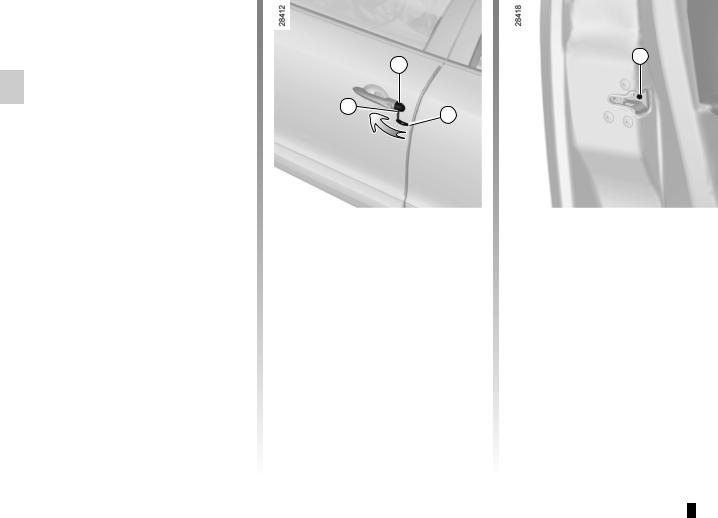
Locking/unlocking the doors (1/2)
Locking/Unlocking the doors from the outside
This is done using the RENAULT Card; see the “RENAULT Card” information in Section 1.
In certain cases, the RENAULT card may not work:
–if the RENAULT card battery is weak, flat, etc.
–if equipment operating on the same frequency as the card (mobile phones, etc.) is used;
–vehicle located in a high electromagnetic radiation zone.
It is then possible:
–to use the key integrated into the card to unlock the front left-hand door;
–to lock each of the doors manually;
–to use the interior door locking/unlocking control (refer to the following pages).
A |
1 |
2 |
|
Using the key integrated in the RENAULT card
–Remove cover A from the left-hand door (using the end of key 2) in notch 1;
–move it upwards to remove cover A;
–insert the key 2 into the lock of the front left-hand door and lock or unlock.
3 |
Locking the doors manually
Turn screw 3 with the door open (using the end of the key) and close the door.
This means that the doors are then locked from the outside.
The doors may then only be opened from the inside or by using the key in the front left-hand door.
1.12
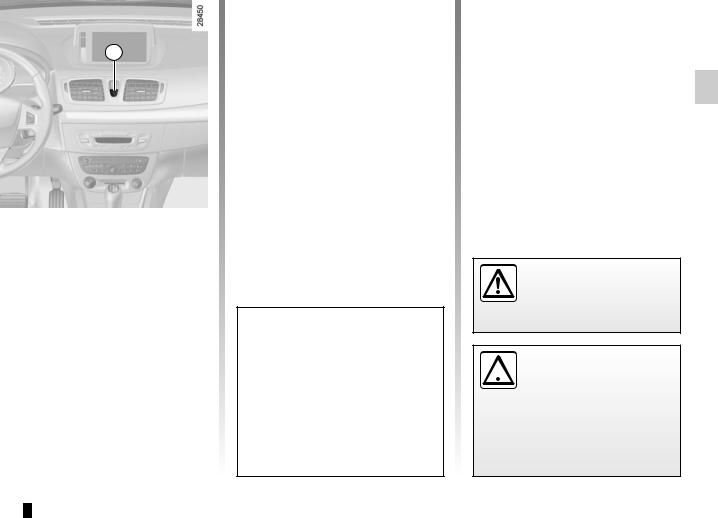
Locking/unlocking the doors (2/2)
4 |
Interior locking/unlocking door control
Switch 4 controls the doors, tailgate and, depending on the vehicle, the fuel filler flap simultaneously.
If a door or the tailgate is open or not closed properly, the doors and tailgate lock/unlock quickly.
If transporting an object with the tailgate open, you can still lock the doors: with the engine stopped, press and hold switch 4 for more than five seconds to lock the other doors.
Locking the doors without the RENAULT card
For example, in the event of a discharged battery or the RENAULT card temporarily not working, etc.
With the engine switched off and a door or tailgate open, press and hold switch 4 for more than five seconds.
When the door is closed, all the doors and the tailgate will be locked.
Unlocking the vehicle from the outside is only possible with the RENAULT card in the vehicle's access zone or using the key integrated in the RENAULT card.
After locking/unlocking the vehicle or the tailgate only using the buttons on the RENAULT card, remote locking and unlocking in hands-free mode are deactivated.
To reactivate the “hands-free” mode: restart the vehicle.
Door and tailgate status indicator
When the ignition is on, the indicator light integrated in switch 4 informs you of the status of the doors and tailgate:
–indicator light on, the doors and tailgate are locked,
–indicator light off, the doors and tailgate are unlocked.
When you lock the doors, the indicator light remains lit and then goes out.
Never leave your vehicle with the RENAULT card inside.
Driver’s responsibility
 If you decide to keep the doors locked when you are driving, remember that it may be more difficult for those as-
If you decide to keep the doors locked when you are driving, remember that it may be more difficult for those as-
sisting you to gain access to the passenger compartment in the event of an emergency.
1.13

Automatic locking when driving
You can decide whether you want to activate this function.
Operating principle
After the vehicle is started, the system automatically locks the doors when you are driving at approximately 6 mph (10 km/h) and over.
The door can be unlocked:
–by pressing the door unlocking button 1.
–by opening a front door (vehicle stationary).
Note: if a door is opened or closed, it will automatically lock again when the vehicle reaches a speed of 6 mph (10 km/h).
Driver’s responsibility
 If you decide to keep the doors locked when you are driving, remember that it may be more difficult for those as-
If you decide to keep the doors locked when you are driving, remember that it may be more difficult for those as-
sisting you to gain access to the passenger compartment in the event of an emergency.
1 |
Activating/deactivating the function
Refer to the information on the “Vehicle settings customisation menu” in Section 1, regarding the “Auto door locking while driving” function:
=function activated
<function deactivated.
Operating faults
If you experience an operating fault (no automatic locking, the indicator light incorporated in button 1 does not light up when trying to lock the doors and tailgate, etc.), firstly check that the doors and tailgate are properly closed. If they are closed correctly, contact an approved dealer.
1.14
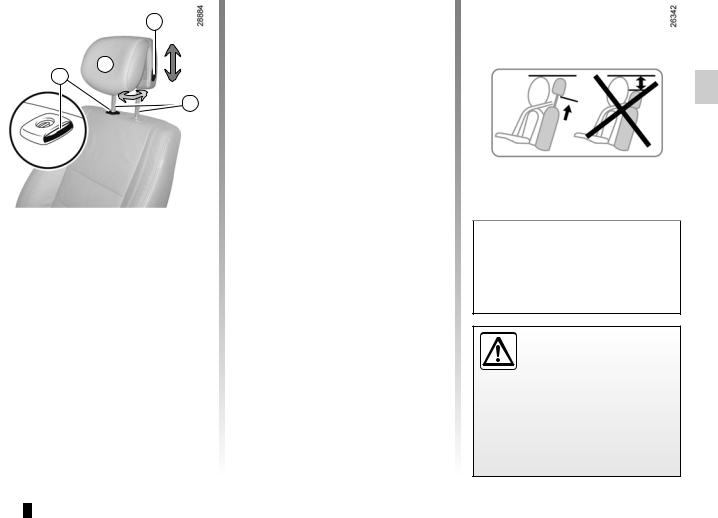
Front headrests
2 |
1 |
A |
|
3 |
To raise the headrest
Pull the headrest upwards to the desired height.
To lower the headrest
Press button 2 and guide the headrest down to the desired height.
To adjust the angle of the headrest
Depending on the vehicle, tilt section A towards or away from you to the required position.
To remove the headrest
Raise the headrest to its highest position (tilt the seatback backwards if necessary). Press button 1 and lift the headrest to release it.
To refit the headrest
Pull out the headrest rods 3 as far as possible by pulling from the top. Take care to ensure they are clean and correctly aligned and, if there are any problems, check that the notches are facing forwards.
Insert the headrest rods into the holes (tilt the seatback backwards if necessary).
Lower the headrest until it locks, press button 1 and lower the headrest as far as possible.
Check that each headrest rod 3 is securely locked in the seatback by trying to pull them up or push them down.
The three upper positions can be manipulated without pressing button 2. However, it is preferable to press this button to lower the headrest.
The headrest is an important safety component: ensure that it is in place and in the correct position. The
distance between your head and the headrest and the distance between the head and section A should be as small as possible.
1.15
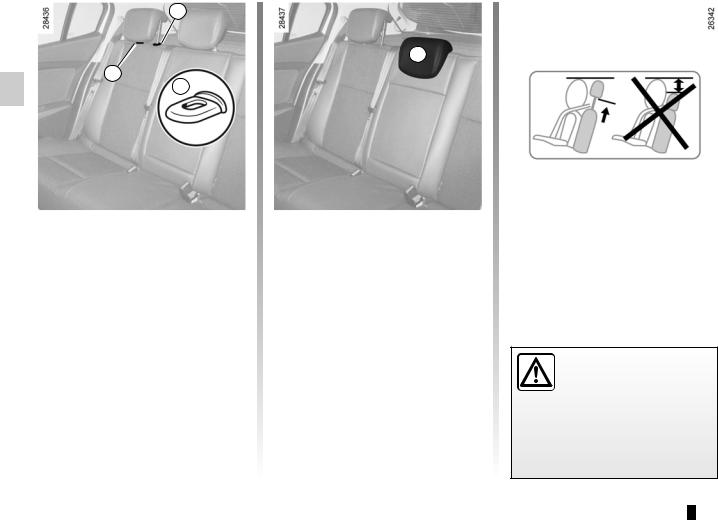
Rear headrests
2 |
B
1
A
Position for use
Raise or lower the headrest while pulling it towards the front of the vehicle.
To remove the headrest
Press tabs A of rods 1 and 2 simultaneously and remove the headrest.
Note: on the three door version, first lower the bench seatback (refer to the information on the “Rear seat functions” in Section 3).
To refit the headrest
Insert the headrest rods into the sleeves, and lower the headrest to the first notch.
Storage position
Lower the headrest as far as possible, then press tab 2 and lower it completely.
When the headrest is set at the lowest position (position B) this is for storage only: it should not be in this position when a seat is occupied.
The headrest is a safety component. Ensure that it is fitted and in the correct position: the top of your head
should be in line with the top of the headrest.
1.16
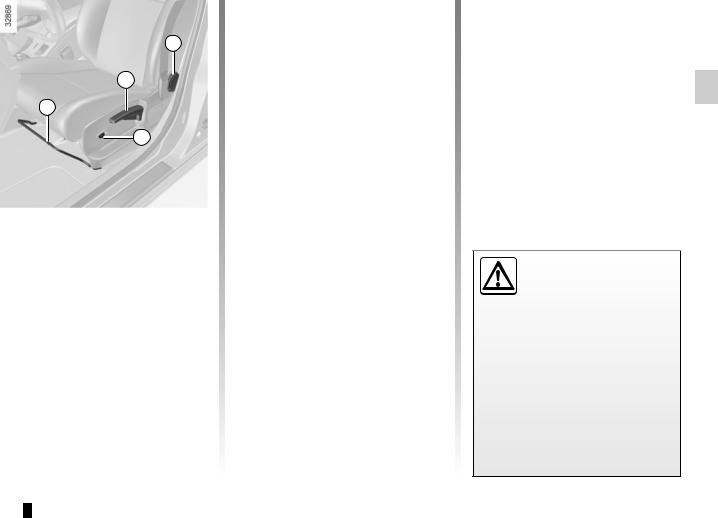
Front seats with manual control (1/2)
3 |
2 |
1 |
4 |
To move the seat forwards or back
Lift handle 1 to release. Release the handle once the seat is in the correct position and ensure that the seat is fully locked into position.
To raise or lower the seat base
Move lever 2 as many times as necessary upwards or downwards.
To tilt the seatback
Turn control knob 3 to the required position.
Heated seats
(depending on vehicle)
With the engine running, turn control 4 to either position I, II or III (depending on the temperature required). An indicator light on the instrument panel lights up once the front seat heating system is operating.
The system, which has a thermostat, decides whether or not the heating is needed, according to the position selected.
For safety reasons, carry out any adjustments when the vehicle is not being
driven.
We would advise you not to recline the seatbacks too far to ensure that the effectiveness of the seat belts is not reduced.
Nothing should be placed on the floor (area in front of driver) as such objects may slide under the pedal during braking manoeuvres, thus obstructing its use.
1.17
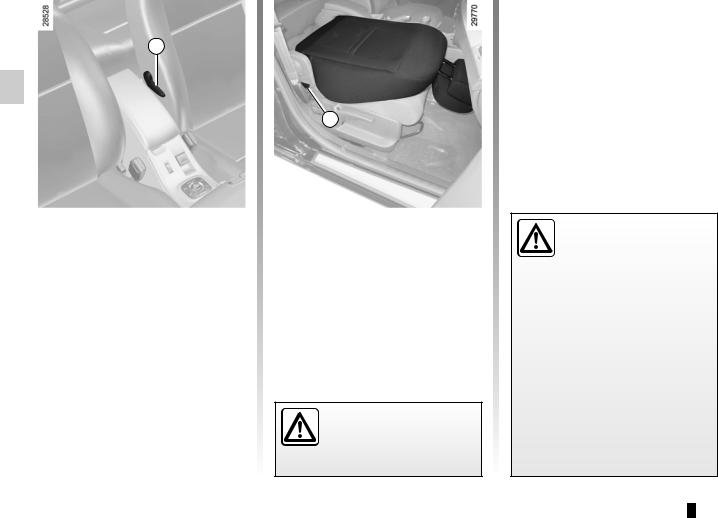
Front seats with manual control (2/2)
5 |
6 |
To adjust the lumbar support on the driver’s seat
Lower handle 5 to increase the support and lift to decrease it.
Table function
Depending on the vehicle, the passenger seatback may be folded down onto the seat base to create a table.
Lower the headrest, move the seat back, tilt handle 6 and completely lower the seatback.
For your safety, attach any transported objects when the seat is in the table position.
When the front seat is in table position, the front passenger air bag must be disabled (see information on
“Child safety: activating/deactivating the front passenger air bag” in Section 1).
Risk of serious injury caused by items resting on the seatback table which may be dislodged when the air bag is deployed.
The label (on the dashboard) and the markings (on the windscreen) remind you of these instructions.
1.18
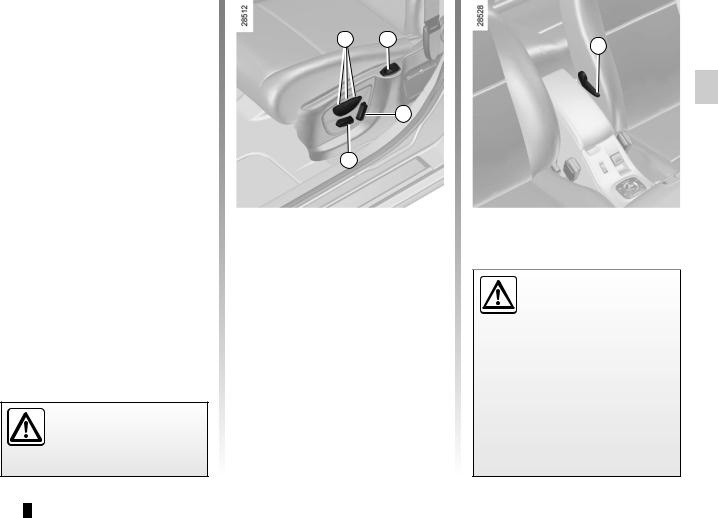
FRONT SEATS WITH ELECTRIC CONTROL
Switch 3 is used for adjusting the seatback and switch 4 is used for adjusting the seat squab.
On equipped vehicles, buttons 1 are used to store the chosen driving position (refer to the following page).
Adjusting the seat squab:
–To move the seat forwards or back
Move switch 4 forwards or backwards.
–To raise or lower the seat base
Move the switch 4 upwards or downwards.
Adjusting the lumbar support on the driver’s seat:
Lower handle 5 to increase the support and lift to decrease it.
For safety reasons, carry out any adjustments when the vehicle is not being driven.
1 |
2 |
3 |
4 |
Adjusting the seatback:
To tilt the seatback, move the top of switch 3 forwards or backwards.
Heated seats
(depending on vehicle)
With the engine running, turn control 2 to either position 1, 2 or 3 (depending on the temperature required). An indicator light on the instrument panel lights up once the front seat heating system is operating.
The system, which has a thermostat, decides whether or not the heating is needed, according to the position selected.
5 |
We would advise you not to recline the seatbacks too far to ensure that the effectiveness of the seat belts is
not reduced.
Nothing should be placed on the floor (area in front of driver) as such objects may slide under the pedal during braking manoeuvres, thus obstructing its use.
1.19
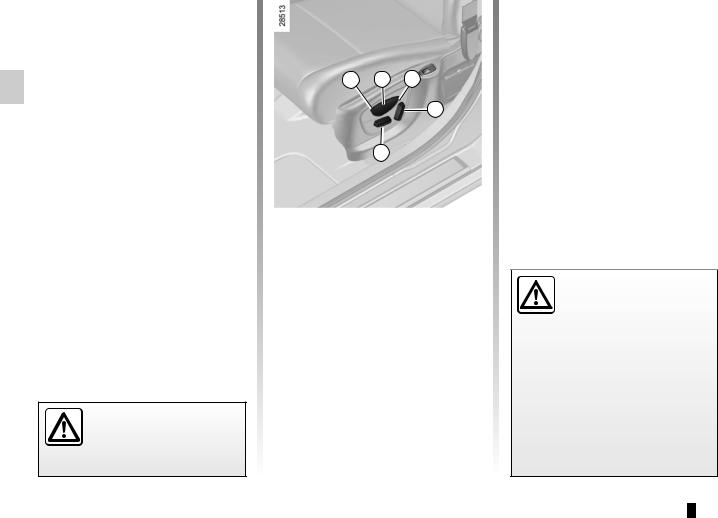
FRONT SEATS WITH ELECTRIC CONTROL with storage of settings
It is possible to store three driving positions.
A driving position includes the settings for the seat base and seatback of the driver’s seat.
The system operates:
–with the “hands-free” card detected or, depending on the vehicle, RENAULT card in the card reader;
–when the driver’s door is opened.
1 |
2 |
3 |
4 |
5 |
For safety reasons, carry out any adjustments when the vehicle is not being driven.
Storing your driving position
–Adjust the seat using switches 4 and 5 (see previous page);
–press one of buttons 1, 2 or 3 until a beep is heard: the driving position is stored;
–to store other driving positions repeat this procedure with the other buttons.
Recalling a stored driving position
With the vehicle stationary, briefly press button 1, 2 or 3 depending on the required stored driving position.
Note: recall of the stored driving position is interrupted if one of the seat adjustment buttons is pressed during recall.
When driving, it is not possible to recall a driving position.
We would advise you not to recline the seatbacks too far to ensure that the effectiveness of the seat belts is
not reduced.
Nothing should be placed on the floor (area in front of driver) as such objects may slide under the pedal during braking manoeuvres, thus obstructing its use.
1.20
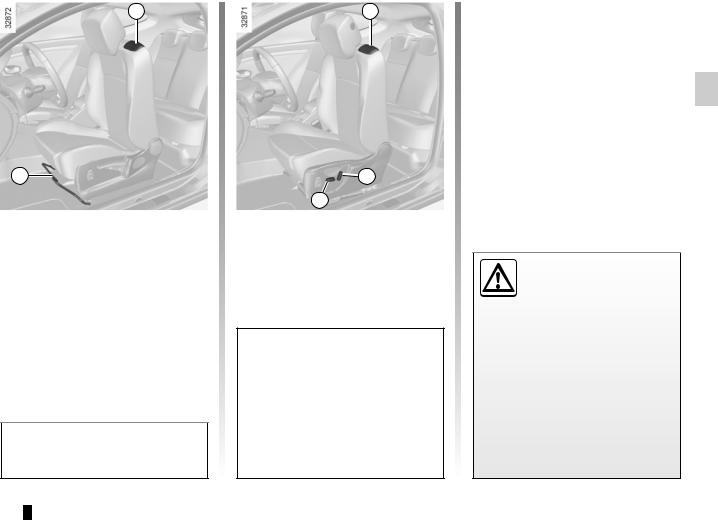
Access to rear seats, three-door version
1 |
1 |
2 |
Manually controlled seats
Lift handle 1 and slide the seat forward.
To return the seat to its original position, bring the seatback back into position.
Do not move handle 1 and handle 2 or switch 4 at the same time.
3 |
4 |
Electrically controlled seats
Lift handle 1 and tilt the seatback completely: the seat moves forward.
To return the seat to its original position, bring the seatback back up. The seat returns to its original position.
Special note: if the seatback is tilted over the rear bench seat, only use control 3 to return it to the driving position.
Never use handle 1 as it is not designed for this purpose: there is a risk of damage to the mechanism.
Locking the seats
When a person, an object or a child seat prevents the front seats from locking, perform the following operations:
–ask all of the passengers to leave the vehicle and remove any bulky objects from the rear seats;
–lock the seat(s) in the initial position again;
–move the seat(s) forwards in order to create sufficient space;
–ask the passengers to get back into the vehicle, and refit the child seat or objects on the rear seats.
Check that no object or person prevents the front seat from locking. If so, remove any obstacles
behind the front seats. Adjust the seat to allow sufficient room in the rear. The rear occupants/objects should then return to the vehicle.
Repeat the above until the seat is locked correctly.
Risk of seat moving on its runners during vehicle acceleration or braking.
1.21
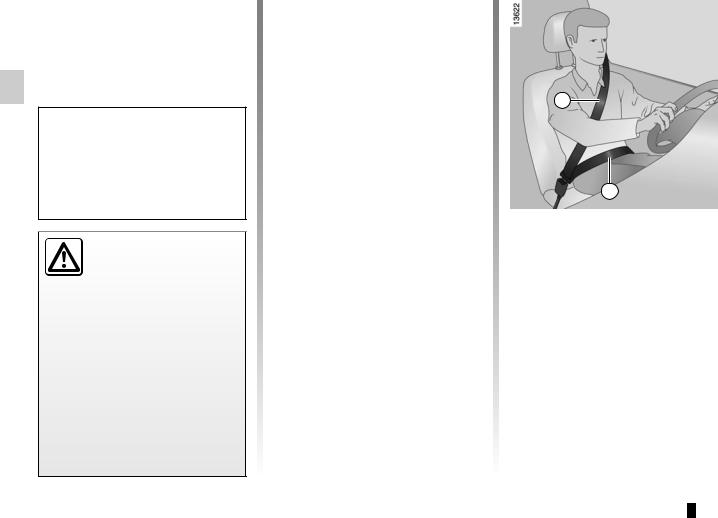
Seat belts (1/3)
Always wear your seat belt when travelling in your vehicle. You must also comply with the legislation of the particular country you are in.
Make sure that the rear bench seat is locked in position correctly so that the rear seat belts will operate efficiently. Refer to the information on the “Rear bench seat” in Section 3.
Incorrectly adjusted or twisted seat belts may cause injuries in the event
of an accident.
Use one seat belt per person, whether child or adult.
Even pregnant women should wear a seat belt. In this case, ensure that the lap belt is not exerting too much pressure on the abdomen, but do not allow any slack.
Before starting, first adjust your driving position, then ask all occupants to adjust their seat belts to ensure optimum protection.
Adjusting your driving position
–Sit well back in your seat (having first removed your coat or jacket). This is essential to ensure your back is positioned correctly;
–adjust the distance between the seat and the pedals. Your seat should be as far back as possible while still allowing you to depress the clutch pedal fully. The seatback should be adjusted so that your arms are slightly bent when you hold the steering wheel;
–adjust the position of your headrest. For maximum safety, your head must be as close as possible to the headrest;
–adjust the height of the seat. This adjustment allows you to select the seat position which offers you the best possible view;
–adjust the position of the steering wheel.
1 |
2 |
Adjusting the seat belts
Sit with your back firmly against the seatback.
Shoulder strap 1 should be as close as possible to the base of the neck but not on it.
Lap belt 2 should be worn flat over the thighs and against the pelvis.
The belt should be worn so that it is as close as possible to your body, i.e.: avoid wearing heavy clothing or keeping bulky objects under the belts, etc.
1.22
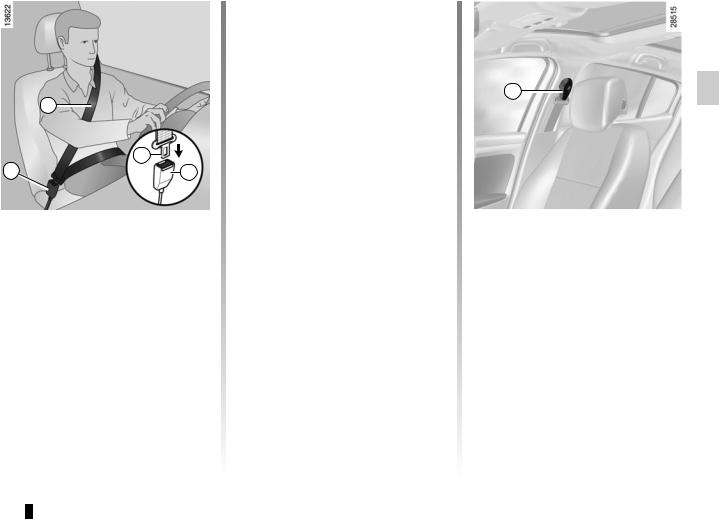
Seat belts (2/3)
1 |
4 |
3 |
4 |
Locking
Unwind the belt slowly and smoothly and ensure that buckle 3 locks into catch 4 (check that it is locked by pulling on buckle 3). If the belt jams, allow it to return slightly before attempting to unwind it again.
If your seat belt is completely jammed, pull slowly, but firmly, so that just over 3 cm unwinds. Allow it to return slightly before attempting to unwind it again.
If there is still a problem, contact an approved dealer.
ß Frontwarningseatlightbelt reminder
This lights up on the central display when the engine is started then, if the driver’s or front passenger’s seat belt (if this seat is occupied) is not fastened and the vehicle has reached approximately 12 mph (20 km/h), it flashes and a bleep sounds for around 2 minutes.
Note: an object placed on the passenger seat base may activate the warning light in some cases.
Rear seat belt reminder (depending on vehicle)
the ßwarning light on the central display lights up accompanied by a message on the instrument panel indicating the number of seat belts buckled for approximately 30 seconds each time:
–the vehicle is started;
–a door is opened;
–a rear seat belt is fastened or unfastened.
Check that the rear passengers are wearing seat belts and that the number of seat belt shown as fastened corresponds to the number of rear bench seat places occupied.
5 |
Adjusting the front seat belt height
(depending on vehicle)
Press button 5 to adjust the seat belt height so that shoulder strap 1 is worn as shown previously:
–to lower the seat belt, press button 5 and lower the seat belt at the same time;
–to raise the seat belt, press button 5 and raise the seat belt at the same time.
Make sure that the seat belt is locked in position correctly after you have adjusted it.
1.23
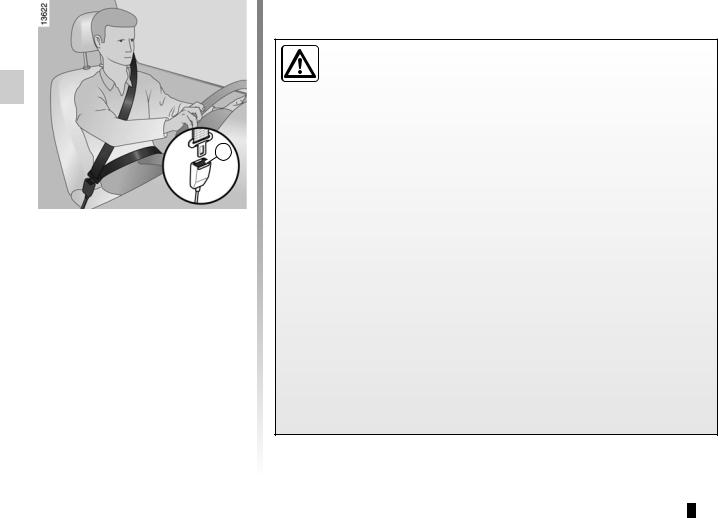
SEAT BELTS (3/3)
6 |
Unfastening
Press button 6 and the seat belt will be rewound by the inertia reel. Guide the belt.
Note: when driving, if a rear seat belt is unbuckled, the message “Rear seat belt unbuckled” appears on the instrument panel.
The following information applies to the vehicle’s front and rear seat belts.
– No modification may be made to the component parts of the restraint system (belts and seats and their mountings) fitted originally. For special operations (e.g. fitting child seats) contact an approved dealer.
– Do not use devices which allow any slack in the belts (e.g. clothes pegs, clips, etc.): a seat belt which is worn too loosely may cause injury in the event of an accident.
–Never wear the shoulder strap under your arm or behind your back.
–Never use the same belt for more than one person and never hold a baby or child on your lap with your seat belt around them.
–The belt should never be twisted.
–Following an accident, have the seat belts checked and replaced if necessary. Always replace your seat belts as soon as they show any signs of wear.
–Make sure that the buckle is inserted into the appropriate catch.
–Ensure that no objects are placed in the area around the seat belt catch as they could prevent it from being properly secured.
–When putting back the rear bench seat, take care that the seat belts are correctly positioned so that they can be used properly.
1.24
